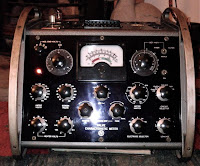 Here is our new pride and joy - a 1960's AVO mkIII valve characteristic meter. It's built like a tank, with wonderful vintage knobs and dials. And comes in handy for getting those amps and mics up and running.
Here is our new pride and joy - a 1960's AVO mkIII valve characteristic meter. It's built like a tank, with wonderful vintage knobs and dials. And comes in handy for getting those amps and mics up and running.
2010/01/07
New Toy!
 Here is our new pride and joy - a 1960's AVO mkIII valve characteristic meter. It's built like a tank, with wonderful vintage knobs and dials. And comes in handy for getting those amps and mics up and running.
Here is our new pride and joy - a 1960's AVO mkIII valve characteristic meter. It's built like a tank, with wonderful vintage knobs and dials. And comes in handy for getting those amps and mics up and running.
2010/01/05
Teladi tube mic
And here's something altogether nicer. It's an old Teladi end-address tube mic, probably from the 1950s. Construction wise, it feels very Gefell, with a small metal (nickel?) diaphragm and a U47 style connector.
 |
| Teladi K120 traced schematic |
2010/01/04
Cheap!
 Broadly speaking, you get what you pay for.
Broadly speaking, you get what you pay for.Over the past 5 years or so the market has become saturated wth inexpensive made-in-china microphones which have brought condenser mics within the budget of home studios and, along with computer based recording, have arguably revolutionised the recording industry. But there has to be some corner cutting or trade-off in component quality or quality control, doesn't there? I picked this SE electronics 'miniSE' up on ebay for £40, which brings it in at about 15 times cheaper than the ex-demo Neumann TLM49 we bought earlier in the year. Like the neumann it is a cardioid-only transformerless mic. And unlike the Neumann, this came in a nice aluminium carrying case (as opposed to cardboard!)
On opening the case, I found the mic was rattling. 2 minutes with a screwdriver revealed that the capsule had not been properly screwed down. Also you can see that the circuit board is covered in flux. The capsule looks exactly the same as the CK12 copies found in MXL2001 mics and others. I've seen several of these now with bumps and wrinkles in the membrane. The metalwork is actually quite nice, so it may get one of the spare AKG capsules and a new circuit transplanted.
Update: Eventually I used this body for a DIY ribbon mic!
2010/01/03
Wetzel microphone on the bench
Here's a nice little tube mic for restoration. The manufacturer is Joachim Wetzel of Liepzig and looks to date from the 50s or 60s.
It is currently undergoing a recap and the capsule will be reskinned. The head amp is based on an ECC83, with two triode gain stages. There's something funny going on with this one. The power supply voltages are somewhat low, and it seems like the old diode rectifiers are causing problems. More on this later.
2010/01/02
Framus Television
 |
| Framus Television |
It is quite sad to think that the success of the big American guitar manufacturers (F--, G--, you know who you are!) led not only to some excellent instruments and high standards of construction, but also to the demise of several smaller builders of quality guitars. Cheap imports from the East added to the problem. One such victim was the German manufacturer Framus, who went bankrupt and ceased production at the end of the '70s. (The company has since been reborn).
Framus made guitars of generally high quality with some interesting features. Here is a 1968 Framus Television semi-acoustic, the shape of which is clearly influenced by Fender's Jaguar/Jazzmaster (or was it the other way round?) . It has a pleasing asymmetry, with a single f-hole (as far as we can tell, most Televisions had two), three pickups, and a tremolo. The headstock shape is whacky - like a big hand - but we like it. Colour of this one is a beautiful stained carrot-orange-yellow, rather like certain Gretschs - we think they call this 'aniline yellow'. It has a laminate top and back.
This guitar arrived on the bench with toggle switches in place of the original sliders, as well as a couple of loose wires, which we of course replaced/fixed. The circuit is slightly unusual (which is why it is on this website at all!), so we've sketched a circuit diagram to help other owners.
 |
| Framus Television circuit |
The circuit consists of two parallel output stages each with volume and tone pots (marked T&V in the diagram) , which the player may use to switch between 'rhythm' and 'lead' settings. This approach predates the days when everyone has booster pedals on the floor, and similar systems are also found on Jaguars and Jazzmasters. In the 'rhythm' position, only the neck pickup is active. In the 'lead' position any combination of the three pickups may be switched on - the pickups in combination give some audible phase cancellation. There is also a bass cut filter switch. A summary of the switches:
S1 = Bridge pickup on/off
S2 = Middle pickup on/off
S3 = Neck pickup on/off
S4 = Bass cut (lead circuit only)
S5a = Sends neck pickup to rhythm or lead tone/volume circuit.
S5b = Switches between lead and rhythm tone/volume circuits.
As the tone and volume pots are tricky to remove and function well, they were not investigated or measured for value. I think they are just standard.
There's a good chance that the circuit is similar to Strato Delux models of similar vintage, which also have up to 5 switches. Do let us know if you can confirm or deny this.
2010/01/01
G7 microphone
1. Using a single sided capsule
2. Some measured voltages:
I built a version of the microphone by etching Gyraf's layout. Wired it up and checked some voltages - and found that the supply is rather low under load. I got about 176 Volts without the mic connected, and was down to 136 V with the mic in the loop. Heater supply dropped from 6.3V (set whilst unloaded) to 6.08V. Here are some voltages for reference.
3. Better matching of the capsule polarisation voltages.
Note in the diagram above that one side of the capsule has a slightly higher voltage than the other - no problem in omni or cardioid but noticeable in figure8 mode when recording Blumlein pairs. Here's a quick fix!

Subscribe to:
Posts (Atom)









